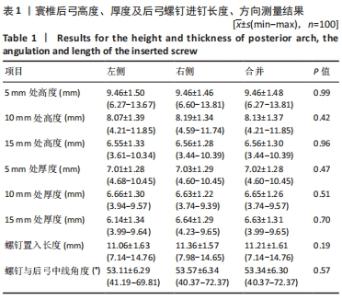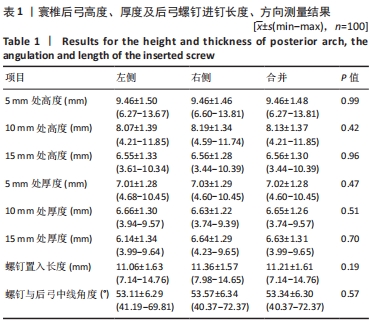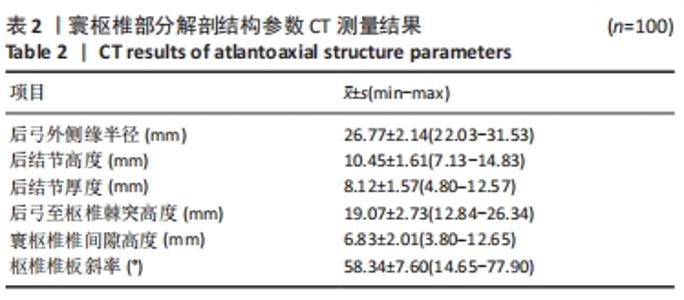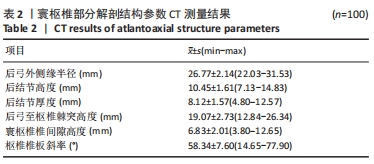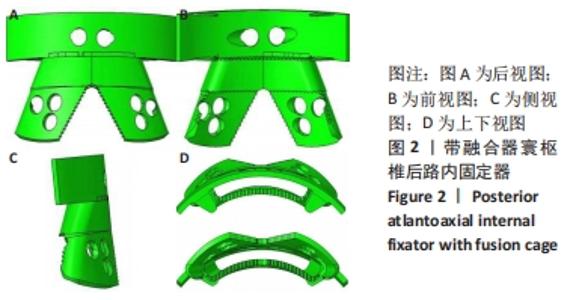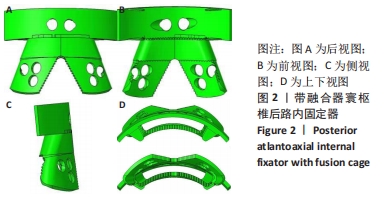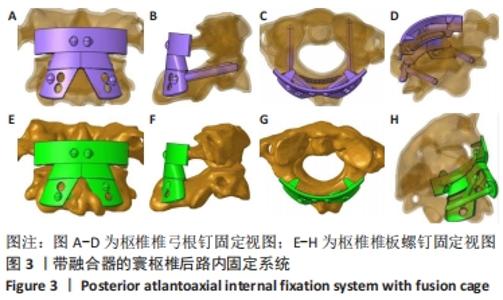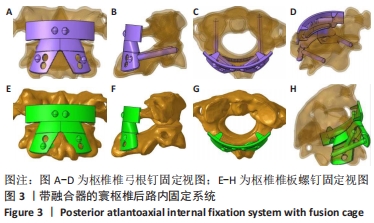[1] YANG HS, KIM KW, OH YM, et al. Usefulness of titanium mesh cage for posterior C1-C2 fixation in patients with atlantoaxial instability. Medicine (Baltimore). 2017;96(36):e8022.
[2] 李浩曦,陈兆雄,刘涛,等.正常成年人寰枢椎直立主动旋转运动特征的研究[J].中国骨与关节损伤杂志,2017,32(9):897-900.
[3] WANG HW, MA LP, YIN YH, et al. Biomechanical Rationale for the Development of Atlantoaxial Instability and Basilar Invagination in Patients with Occipitalization of the Atlas: A Finite Element Analysis. World Neurosurg. 2019;127:e474-e479.
[4] CHEN J, ZHOU F, NI B, et al. New Posterior Atlantoaxial Restricted Non-Fusion Fixation for Atlantoaxial Instability: A Biomechanical Study. Neurosurgery. 2016;78(5):735-741.
[5] CHUN DH, YOON DH, KIM KN, et al. Biomechanical Comparison of Four Different Atlantoaxial Posterior Fixation Constructs in Adults: A Finite Element Study. Spine (Phila Pa 1976). 2018;43(15):E891-E897.
[6] LIU C, KAMARA A, YAN Y. Biomechanical study of C1 posterior arch crossing screw and C2 lamina screw fixations for atlantoaxial joint instability. J Orthop Surg Res. 2020;15(1):156.
[7] 杨敏,马向阳,杨进城,等.自行防旋转寰枢椎钉棒内固定系统的生物力学有限元分析[J].中国组织工程研究,2017,21(19):3031-3037.
[8] 潘保顺,唐焕章,陈金水,等.一种新型后路寰枢椎固定系统的设计及有限元分析[J].中国脊柱脊髓杂志,2020,30(4):353-359.
[9] RAJINDA P, TOWIWAT S, CHIRAPPAPHA P. Comparison of outcomes after atlantoaxial fusion with C1 lateral mass-C2 pedicle screws and C1-C2 transarticular screws. Eur Spine J. 2017;26(4):1064-1072.
[10] LARSEN AMG, GRANNAN BL, KOFFIE RM, et al. Atlantoaxial Fusion Using C1 Sublaminar Cables and C2 Translaminar Screws. Oper Neurosurg (Hagerstown). 2018;14(6):647-653.
[11] XIE W, GAO P, JI L. Three-dimensional spiral CT measurement of atlantal pedicle and its clinical application. Exp Ther Med. 2017;14(2):1467-1474.
[12] ZHANG Y, LI C, LI L, et al. Design a novel integrated screw for minimally invasive atlantoaxial anterior transarticular screw fixation: a finite element analysis. J Orthop Surg Res. 2020;15(1):244.
[13] 邹小宝,马向阳,王宾宾,等.CT测量成人寰枢椎后方部分结构数据设计寰枢椎板间融合器[J].中国组织工程研究,2020,24(36): 5837-5842.
[14] 潘保顺,唐焕章,陈金水,等.寰椎后弓影像学的测量与新型寰椎后弓内固定器的设计[J].中国骨与关节损伤杂志,2020,35(5):449-452.
[15] FLOYD T, GROB D. Translaminar screws in the atlas. Spine (Phila Pa 1976). 2000;25(22):2913-2915.
[16] GUO X, NI B, ZHAO W, et al. Biomechanical assessment of bilateral C1 laminar hook and C1-2 transarticular screws and bone graft for atlantoaxial instability. J Spinal Disord Tech. 2009;22(8):578-585.
[17] KELLY BP, GLASER JA, DIANGELO DJ. Biomechanical comparison of a novel C1 posterior locking plate with the harms technique in a C1-C2 fixation model. Spine (Phila Pa 1976). 2008;33(24):E920-925.
[18] HARMS J, MELCHER RP. Posterior C1-C2 fusion with polyaxial screw and rod fixation. Spine (Phila Pa 1976). 2001;26(22):2467-2471.
[19] PHAM MH, BAKHSHESHIAN J, REID PC, et al. Evaluation of C2 pedicle screw placement via the freehand technique by neurosurgical trainees. J Neurosurg Spine. 2018;29(3):235-240.
[20] 马向阳,尹庆水,吴增晖,等.枢椎椎弓根螺钉进钉点的解剖定位研究[J].中华外科杂志,2006,44(8):562-564.
[21] CHYTAS D, KORRES DS, BABIS GC, et al. Anatomical considerations of C2 lamina for the placement of translaminar screw: a review of the literature. Eur J Orthop Surg Traumatol. 2018;28(3):343-349.
[22] 邹小宝,马向阳,杨浩志,等.新型后路寰枢椎板间融合器生物力学特征的有限元分析[J].中国组织工程研究,2019,23(28):4529-4534.
[23] RYU JI, BAK KH, YI HJ, et al. Evaluation of the Efficacy of Titanium Mesh Cages with Posterior C1 Lateral Mass and C2 Pedicle Screw Fixation in Patients with Atlantoaxial Instability. World Neurosurg. 2016;90:103-108.
[24] JIN GX, WANG H, LI L, et al. C1 posterior arch crossing screw fixation for atlantoaxial joint instability. Spine (Phila Pa 1976). 2013;38(22):E1397-1404.
[25] CHRISTENSEN DM, EASTLACK RK, LYNCH JJ, et al. C1 anatomy and dimensions relative to lateral mass screw placement. Spine (Phila Pa 1976). 2007;32(8):844-848.
[26] 王宾宾,马向阳,段明阳,等.成人寰椎后弓部分结构测量及意义[J].中国临床解剖学杂志,2017,35(6):610-614.
[27] NATSIS K, PIPERAKI ET, FRATZOGLOU M, et al. Atlas posterior arch and vertebral artery’s groove variants: a classification, morphometric study, clinical and surgical implications. Surg Radiol Anat. 2019;41(9):985-1001.
[28] DONNELLAN MB, SERGIDES IG, SEARS WR. Atlantoaxial stabilization using multiaxial C-1 posterior arch screws. J Neurosurg Spine. 2008; 9(6):522-527.
[29] WRIGHT NM. Posterior C2 fixation using bilateral, crossing C2 laminar screws: case series and technical note. J Spinal Disord Tech. 2004;17(2):158-162.
[30] GOEL A, KULKARNI AG, SHARMA P. Reduction of fixed atlantoaxial dislocation in 24 cases: technical note. J Neurosurg Spine. 2005;2(4): 505-509.
|
